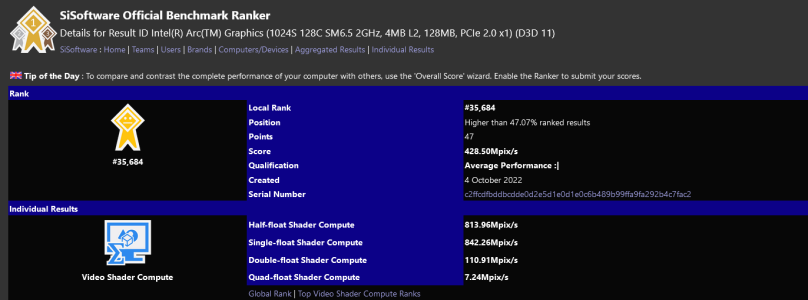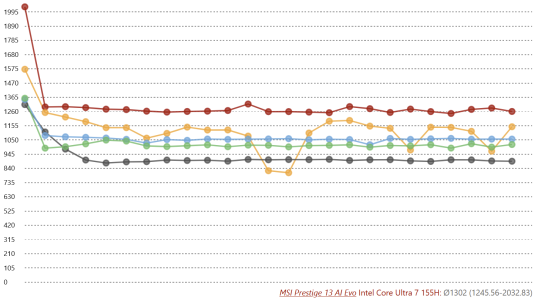- Mar 3, 2017
- 1,777
- 6,791
- 136
He probably means in term of price target and battery life. Granted, I expect Lunar Lake to be priced very high due to N3B and tiled approach. Intel will probably ask outrageous prices from OEMs to mandate that LNL is to be used on premium T&L devices, which to me is the same error they did with Core M/Core Y.It's just a cheaper strix.
Well no.He probably means in term of price target and battery life
And MoP. That's a direct cost adder.Granted, I expect Lunar Lake to be priced very high due to N3B and tiled approach
not anymore.Intel will probably ask outrageous prices from OEMs to mandate that LNL is to be used on premium T&L devices
LNL should still be more efficient in that case.still offering competitive battery life
it's a product of many new's for Intel so worth it in itself.Otherwise, LNL as a whole would a huge waste.
For such a cache/bandwidth starved implementation of RDNA, that's really good. AMD basically giving an integrated RTX 3050 35 - 50W with every STX SoC, but without the VRAM bottleneck.
In theory, OEMs could create T&L entry level Gaming Laptops with it. Or users could simply buy an office/premium T&L laptop and still be able to game at 1080p Low/Medium with reasonable settings.
yupI must be getting old. You keep saying T&L and I keep reading it as "Transform & Lighting". Hardware T&L was a big deal back in the day.
Then I realized you meant Thin & Light.
Well no.
Not a premium tablet part, but a mainstream Strix.
So I'm assuming what you mean is that LNL is targeted at >$1000 premium devices while KRK is targeting <$1000 mainstream devices. So very different markets.And MoP. That's a direct cost adder.
Aye. But if KRK can offer similar or close to battery life while offering nearly 2x CPU performance and a better and more mature GFX solution while at much lower price points, it makes LNL much less appealing in my view.LNL should still be more efficient in that case.
Hopefully. lmao.
Right. Special products like Lakefield or LNL still offer much learnings that can be re-used in the future, even if they themselves fail. They're worthwhile experiences.it's a product of many new's for Intel so worth it in itself
Transform and Lighting Laptops would be a very rad name 😁I must be getting old. You keep saying T&L and I keep reading it as "Transform & Lighting". Hardware T&L was a big deal back in the day.
Then I realized you meant Thin & Light.
My bad. I forgot that LNL is a replacement for MTL-U which has 4 Xe cores.MTL has 8 Xe-LPG cores, not 4!
What we should expect from Lunar Lake IGP I don't know.
But I am not even sure, If AMD will have a direct competitor against It, maybe Kraken Point? 4+4 and 8CU looks pretty similar.


That "review" is more about MSI screwing up the firmware than the incompetence of Arc.???
No, you're underestimating how arse MTL is. LNL being as good as it is at 15W relative to MTL only puts it on par with PHX at 15W.
MTL is utterly unusable at 15W, it consistently falls far short of Phoenix on average frame rates and has utterly unplayable frame times to boot at 25W. It just gets even worse at 15W.
no, MTL-H just falls apart below 30w.That "review" is more about MSI screwing up the firmware than the incompetence of Arc.
Obviously not yet, every Zen DT dev.cycle involves two separate designs (as well as two masks, two MB prototypes, dev teams, etc.) for the current and future platform, and when the time comes (usually couple of days before launch) just decide which one to throw to hellAMD has most definitely decided. They are just holding their cards close to their vest. Almost all of these decisions/changes occur internally a year a two b/4 they are leaked. Even board partners are getting specs far later than they did 10 years ago. Such is the state of a very competitive market.
Is that why Asus is able to make a 14 inch laptop with the 155H and give it 17% faster memory than the MSI 13 inch model and score 1.7x the MSI at 64W/20W PL2/PL1 for both?no, MTL-H just falls apart below 30w.
you're welcome.
Is that why Asus is able to make a 14 inch laptop with the 155H and give it 17% faster memory than the MSI 13 inch model and score 1.7x the MSI at 64W/20W PL2/PL1 for both?
no it's just that 15/20W MTL-H gfx results are bad.Is that why Asus is able to make a 14 inch laptop with the 155H and give it 17% faster memory than the MSI 13 inch model and score 1.7x the MSI at 64W/20W PL2/PL1 for both?
Sure:Do you have a link to said results?
Yes, Time Spy takes long enough to run that eventually package power will stabilize at 20 W if you've set PL1 at 20 W.no it's just that 15/20W MTL-H gfx results are bad.
can you not?
I'm not even talking timespy.Time Spy takes long enough to run that eventually package power will stabilize at 20 W if you've set PL1 at 20 W.
Alder-U was pretty awful so hopefully never again.Looks to me like you've never used a recent Intel iGPU in a laptop before.
You're not seriously trying to suggest that in any situation a standard laptop chip would see significant gains to iGPU performance above 50W, are you?That "review" is more about MSI screwing up the firmware than the incompetence of Arc.
On Notebookcheck the MSI prestige Evo 16 needs 110 W boost power to achieve the same TS score as a Lenovo Yoga 7 with 50 W boost power.
MSI prestige 13 AI Evo scores 2178, while the Asus Zenbook 14 scores 3427.Can you be a little more specific than an article with a score of benchmarks across multiple models?
The MSI handheld having performance issues and the MSI laptop needing twice the power to achieve the same benchmark results as other OEMs doesn't make you pause to think that MSI might be the culprit?You're not seriously trying to suggest that in any situation a standard laptop chip would see significant gains to iGPU performance above 50W, are you?
That's well, well, well beyond the region of diminishing returns. So common sense would state that something is clearly more wrong than you're letting on.
After a bit of googling later to find the article you conveniently forgot to post, yeah obviously it didn't make sense. In The Witcher 3 this laptop doesn't peak above 70W. As an actual game, TW3 actually puts a load on the CPU as well, TS doesn't really do that well. I've no doubt during the TS test this device was actually pulling less than 70W.
Anyway, performance at low power is something Intel acknowledged was an issue very close to launch, and they said they'd release firmware updates to fix it. They still haven't done so, and this isn't on MSi to fix. There's nothing for them to do.
Scores at barely 25W for the MSI and at 45W for the Asus, so the latter get roughly 2x the power for the GPU, this can be seen in the power measurements with Furmark, so you re left one more time using gross lies to prop up your intelmania.MSI prestige 13 AI Evo scores 2178, while the Asus Zenbook 14 scores 3427.
You'll need to check with an optometrist - your eyes are failing - when you cannot see that it is clearly stated in the reviews what power levels the models run at.Scores at barely 25W for the MSI and at 45W for the Asus, so the latter get roughly 2x the power for the GPU, this can be seen in the power measurements with Furmark, so you re left one more time using gross lies to prop up your intelmania.
Now if we can get back to the topic subject and stop all this thread trashing with your
usual fairy tales.
MSI prestige 13 AI Evo scores 2178, while the Asus Zenbook 14 scores 3427.



That's total power consumption you are trying to show in the table.Thanks, but is it really that hard to see why the Asus scores much higher? Just because they have the same PL2/PL1 setting, doesn't mean they have the same power consumption.
If your firmware power management is whack at higher power, chances are that it might be the same at lower power.So yeah, nothing unusual here, MSI's just configuring for more power savings with a very short turbo window. This won't change anything in a completely power constrained situation though, like with the MSI Claw.
no, it just sucks at low watts.If your firmware power management is whack at higher power, chances are that it might be the same at lower power.
please stop the cope.Which is my interpretation of the MSI claw results.


